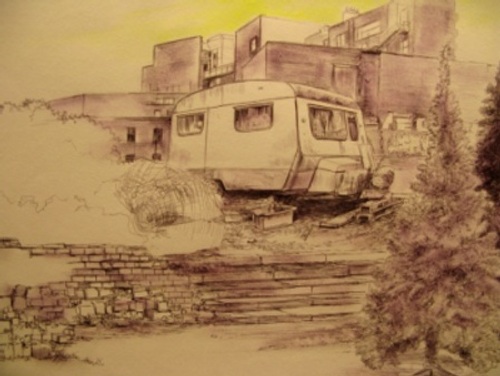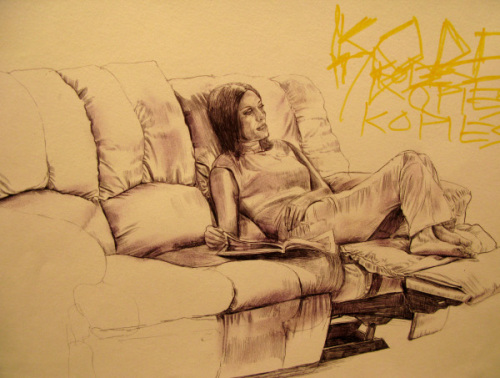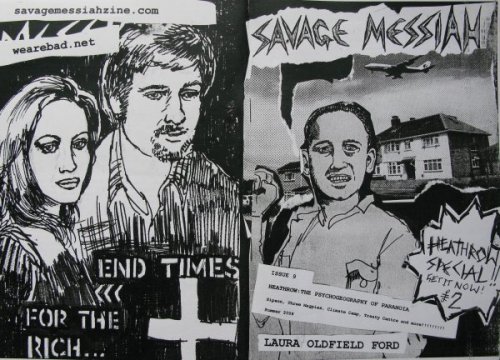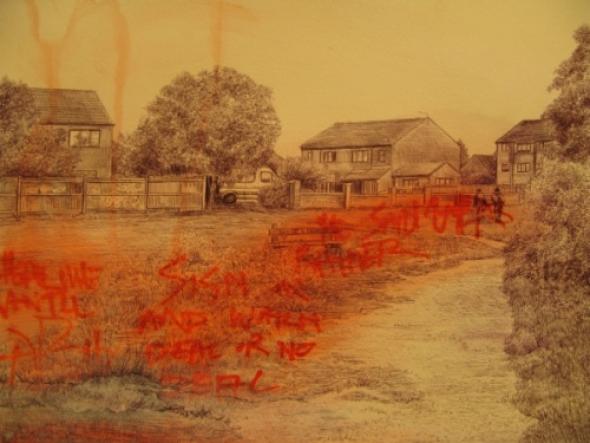Deriving Under the Influence
Colliding anarchistic subcultures, zombified yuppies and the ruins of the welfare state, Laura Oldfield Ford's work opens up the economic and cultural wounds of London's regeneration. Review by Chris Jones
Spitalfields has been described as London's first industrial suburb. But now The City is moving outwards. It wants the land of outcasts for itself
– Charlie Forman, Spitalfields: A Battle For Land (1989)
Brick Lane holds a particular, disorientating memory for me. When stumbling as a teenager through off-my-map streets of London, it was at Brick Lane that I first saw what real poverty was. Not the prosaic suburban poverty of where I was brought up, but the everyday poverty of grim survival. Away from the market proper, at the point where Bethnal Green Road rounds into Shoreditch High St., people had spread stuff out on the pavement and were attempting to make a few quid. People from all nations hawked stuff from all over. Here were heaps of rescued rubbish re-imagined as goods: salvaged nails, tatty hardback books, gone off saucepans.
This feeling of disorientation came back to me when I went to the Laura Oldfield Ford exhibition. It doesn't take a book to know that I was walking through an area over which the battle had been lost, but it helps. Charlie Forman's Spitalfields: A Battle for Land details the fight of local Bangladeshi people against a wave of City-led ‘regeneration' for decent housing in the communities where they already lived. Despite some victories, the locals were cast out and the community's businesses moved on or closed. Now the area has been developed with over-glassed high-rises and endless shopping. Spitalfields, once a beautiful place to just walk around in reverie, slowly begins to look like any other mega-complex from New Labour's alleged new economy.
Walking up from London Bridge, I arrive once more where Bethnal Green Road rounds into Shoreditch High St and ask to be buzzed in to the private space of Hales Gallery.
Banged Up: London 2013, Drifting through the Ruins
Inside the outcasts have come back. The ruins have come back. But they are back as images. One wall of the gallery space has been given up to over one hundred of Laura Oldfield Ford's drawings. Here are evocations of time spent wandering in the ruins of the East End after a failed 2012 Olympics. Each image is finely realistic, copied from photos, and so places are familiar to anyone who has been around the London block once or twice. Displayed in tight formation five high by a dozen or so wide, all drawings are the same size; you have to find your own way in. In a conventional fashion I moved from left to right and looked into each drawing to discern the detail and depth of what is there.
These images are not simple landscapes that show us what Oldfield Ford has seen, but intricate montages of places and people that often continue from one sheet to the next. There are views of brutalist towers, but older more poignant local details stand out: old iron and brickwork, dead industrial chimneys, the flow of water through canals, wooden pallets stacked on the wharf's side or the dark fast tides of the Thames alongside old tyres on a jetty. Trees and pylons, corrugated iron fencing, metal bollards, dense foliage – all this approaches something like an urban pastoral. These are interzonal territories that fall between the twin evils of work time and leisure. If you climb over fences onto waste grounds you will probably find the perfect place to skive, to rethink urbanity and to come down slowly from the rat race you have left behind (albeit temporarily). I like the sad image of a caravan that crops up amidst the ruins, ready and waiting for a cheap holiday in your own misery, the perfect proletarian getaway vehicle.
It's in these pictured sites of dereliction that I imagine all-night raves or punk squats and secret meetings around bonfires, the passing of the bottle - or more so a spliff - because we had needed to create adult gang huts or play dens among the debris to keep ourselves alive, to ward off our impending, collective zombification. These are wasted spaces only if looked at from the perspective of money making, for these are sites where notions of affluence are contested. Better to have time to explore the ruins than to have money to spend in Ikea.
In the midst of the wastelands and the falling down communities, there is also a population but it's a quiet one. In fact some of the pictures seem like film stills or scenes from short stories. Here two men cross an empty space. Here a woman in a hood stares out of the frame. We don't know what happens next. Not only can we not work out these stories, but nobody is telling either. This collection of pictures of overly-public spaces seems oddly mute and devoid of sound despite them being feral places that seek conversation. Even a bunch of punks in a high street standing by an out-of-place fairground ride, all studs, hairdos and painted leathers seem like ghosts where we would expect noise and movement.
There is a deliberate tension placed between Oldfield Ford's images of ruins and working people, and her depiction of yuppies. The yuppies are almost parodies of themselves, if that's possible. Copied from advert-paeans to luxury and wealth and domestic security (a woman lounging on a sofa with a glass of wine in hand as if the sofa was the only partner she ever needed, a couple - she with too much hair takes a cocktail from him with too many teeth), these are pictures of people caught in a state of grotesque, self-conscious playfulness brought on by the presence of too much money. But these aspirational types are not left in peace for long; slogans and sentences rise out of the drawings: ‘Beware the Mindfuckers', ‘Loot Asda, Burn Barratts', ‘Wrecker Vandals Criminals St. Modwen' - St. Modwen being a builder of yuppie enclaves.

From Jago to Day-Glo and Back Again
Tower blocks, concrete jungles and UK decay were the signal aesthetic of punk when it crashed the late 1970s culture party. Punk has influenced Laura Oldfield Ford a great deal. Not only does the style continue in her past and present drawings, but you get the sense that the essential political project of autonomy and doing-it-yourself remains just as important. Using the wastelands to hide from the ravages of the economy, punks, squatters, urban nomads, sufferers, ravers, tramps, outcasts all utilise these inner-city desert islands to re-invent and experiment with free spaces.
This sense of what you could call ‘ruinism' is strongest when you sit back from the wall of images and look upon the collection in its entirety. Although these drawings are made in black biro on white art paper, smudges and stains of Day-Glo pink, yellow and red are streaked across many of the drawings. To me, this summons up D.I.Y. punk fashion's early ludic call for festival among the dreary ruins before punk became only about black and white. But then this is also the colour of Day-Glo signs in the High Street that shriek SALE! SALE! SALE! as everything gets slowly commodified - punk, anarchy, free spaces.
Standing back from it all and viewing it as a whole is rewarding. In its totality, with colours blurring across the swathes of decrepitude, you could convince yourself that another country had suddenly been revealed to you alone. The old and familiar landscapes turn warmly unfamiliar, and zones of escape are suddenly opened up. It would be here that we can see Oldfield Ford's explicit reference and use of the Situationists' early practice of dérive and psychogeography. That is, to drift (dérive) from place to place, moving not out of the desire to get from A to B but through the emotional influence of ambiance, danger, joy, chance encounter and so on. We cannot drift here and now through these images alone, but some sense of possibility can be gained from the insistence that another life is possible in self-created, autonomous zones, where dereliction can be viewed as a safe haven from the ever-expanding banality of the yuppie territories.
Set We Free: London 2009, Drifting through the New Builds
Laid out beneath me were the old Camden squatlands...I paused over the shocking montage of Carol Street, a brutal dichotomy, Scritti Politti's Green Gartside reading Derrida on one side and Ian Stuart leafing through Mein Kampf on the other.
– Savage Messiah, Issue 8
Hales Gallery is situated within what is now called The Tea Building, a former tea warehouse which is now ‘East London's new centre for media and creative industry'. It feels better to be outside the gallery and I walk behind the building to enter what was once called the Nichol (after Nichol St.), but which is more commonly known as the Jago from Arthur Morrison's book A Child Of the Jago. Published in 1896, Morrison shone a reforming light on what was then ‘the blackest pit in London', infamous for its poverty and its ‘howling sea of human wreckage'. Ironically when change came in the form of the Boundary Street Estate two years later, the casual poor, too poverty stricken to afford the new flats, were cast out of the area. I'm not sure we ever remember these previous class cleansings as we walk about in newly gentrified areas like Spitalfields. The cycle just goes on and on, the name ‘Tea Building' is mere heritage and not history.

Laura Oldfield Ford is going in (at least) two directions at once. As a long-time denizen of London's squatting, punk and anarchist scenes, she remains part of a trajectory of people who gave a shit back through many and varied tumultuous occasions - Miner's Strike, Class War, Poll Tax riot, J18, Wombles - and into the future. Alongside that more angry and bilious continuum, she has been hard at work - Slade, Royal College of Art, Valerie Beston Award winner and subsequent exhibition at the Marlborough Fine Art Gallery, Mayfair.
Outside the confines of the gallery walls she works with the artist collective We Are Bad, producing uptight and angry denunciations of the London Olympics and frustrating the squeaky clean image of the Games via constant flyposting on the lengthy blue fence of the 2012 exclusion zone. She also produces the zine Savage Messiah which in some ways is a lot more confrontational and angry, the imagery less subtle than those on display in the exhibition. It's also a lot more contradictory and its wilder energies seemed harder to appreciate in the deadening silence of the gallery where the first ten issues were wired to a table for your delight.
Full of drawings, photos, stories and rants, memories of drunken nights in Hackney or Elephant, each issue of Savage Messiah is situated somewhere in London - a voyage out towards Heathrow, or through the Lea Valley wilderness. Looking through Issue 8, a drift from old King's Cross to Hackney Wick, these are the collisions that hit you - a collage of self-portraits, solid blocks of typewritten text, quotes by Genet or Benjamin or Freud, a skinhead in a defiant pose. ‘ASBO DEFIANCE', ‘OCCUPY THE OLYMPIC VILLAGE - SQUAT THE YUPPIEDROMES' and an advert for ‘Luxury Apartments' defaced with ‘Wreck, Loot, Burn'. Photos of the shabby outside of where Rimbaud and Verlaine lived on Royal College Street sit by assorted other fragments: Italian fascist graffiti, a junkie injecting into her foot, a skinhead dance, cops with short shields from the Poll Tax riot, death threats to estate agents and, a Savage Messiah favourite, ‘ultraviolence'.
This term crops up a lot. Is it a call for proletarian revenge against the toffs and the yuppies? It wouldn't be the most useful analysis of social relations especially in a world of increasingly precarious conditions for many. It's definitely more incisive as parody. The hysteria around the term ‘chav' shows that it's common for those with real economic power to still fear the ‘savage' nature of the lower orders. Far better for Oldfield Ford to make a bit of cash from selling these drawings to a trendy couple who are happy to objectify the poor with their love of ‘council estate chic' than to fall into the overly self-conscious role of the avenging ‘savage' from the ‘darkest streets'. In my own humble experience, such swagger and anti-intellectualism often work against us in the end, when class politics begins with closure and stereotype wielded against expansion and the self-confidence to be everything instead of nothing.
As a jolly council tenant myself, I'm not so excited anyway by increasing ultraviolence especially when I already feel caught up in a web of disciplinary scenarios. Locally, regeneration schemes turn ‘trickle-down' into being pissed on from a great height, and local council biopolitics mean that minor infractions of your tenancy agreement result in Ludivico's Technique in the back room of the housing office. Between being forced to watch endless films on good behaviour on the one hand, and wannabe gangsters pulling weapons at the slightest agitation on the other, I'm not so big on community atomisation.
For all the desire to expound a utopia for the poor amongst the debris and for all the radical history that we can throw at it to inspire ourselves to keep on keeping on, there is also another, more definite non-poetic reality for most of us. Myself, I would prefer my tower block to be a free space of exploration for all, but then I get tired of junkies leaving half-eaten packs of Jammy Dodgers on the landing and prostitutes giving ten quid blow-jobs to Polish labourers outside my front door. These are the ruins we live in then. Ironically it may be the current credit crisis itself that does more to halt regeneration (Olympic or otherwise) than any active class anger, although this may only be their lull before our storm.
Disorientation (Rewind)
I like a great deal of what can be brought to mind from 2013: Drifting through the Ruins, but then sadly I'm also a bit too long in the tooth to be content with it. I'm not sure where gallery shows sit in relation to all these vital themes - class politics, gentrification, the marvelous in the everyday, exodus. Despite the bile and subtlety, this show sits right at the edge of these themes because it chooses to represent them inside what I consider disputed territory, despite everyone's good intentions.

Image: Savage Messiah, Issue 9
Ten minutes after leaving the exhibition, I am walking up Great Eastern Street and I feel that familiar disorientation once again. Without irony and with full middle class over-confidence, an expensive clothes shop called A Child of The Jago has filled its window with ‘Cashmere Workers Hats' for sale to anyone loaded and clueless enough to sport one. Art may be a useful weapon against this insidious class war, but it will not win the battle as a worm in the bud. Laura Oldfield Ford is right now both inside and outside this process. I prefer the cut and paste immediacy and directness of Savage Messiah. Essentially ephemeral, the zine moves round London from hand to hand inspiring a certain righteous gobbyness, remembering but also demanding more rage, more rebellion.
Despite the poignancy and everyday poetry of 2013: Drifting through the Ruins, I can't separate out these themes from the context of both the constricted, non-feral space of the gallery and its very location. It's hard to avoid the reductionism and the enclosure that goes with these spaces. Hales Gallery is happy to trumpet its recent move into ‘the Hoxditch culture project' of the Tea Building. It can also talk about how its ‘proper role in the yBa scene of the '90s gives Hales true credibility'. I don't think Oldfield Ford needs her credibility to be reflected back from a commercial art scene. More likely the gallery prefers the reflection her credibility gives to it. It's great what she does, but it lacks a critique of art and the role of the artist. This is the radical position that is spread across the avant-gardes of the 20th Century and should not be missed out of any updated project of psychogeography that remains interested in social antagonism. But then these are the complications and contradictions that all politicised artists face at some point and it never pays the rent. What to do?
Chris Jones <chris56a AT yahoo.co.uk> is a prisoner at 56a Infoshop in South London. Visiting times here: http://www.56a.org.uk
Info
Savage Messiah, http://savagemessiahzine.com/
Laura Oldfield Ford's London 2013: Drifting through the Ruins was at the Hales gallery, London, 30 Jan - 14 March 2009
Mute Books Orders
For Mute Books distribution contact Anagram Books
contact@anagrambooks.com
For online purchases visit anagrambooks.com








